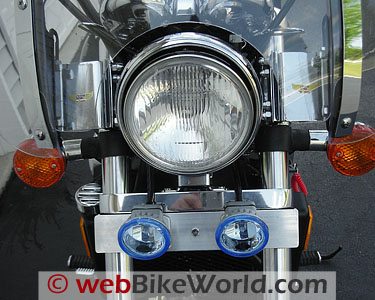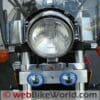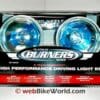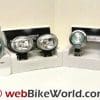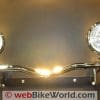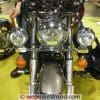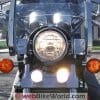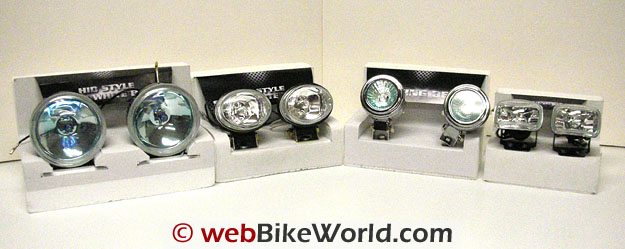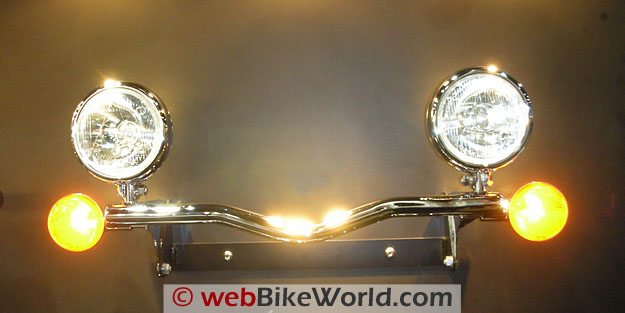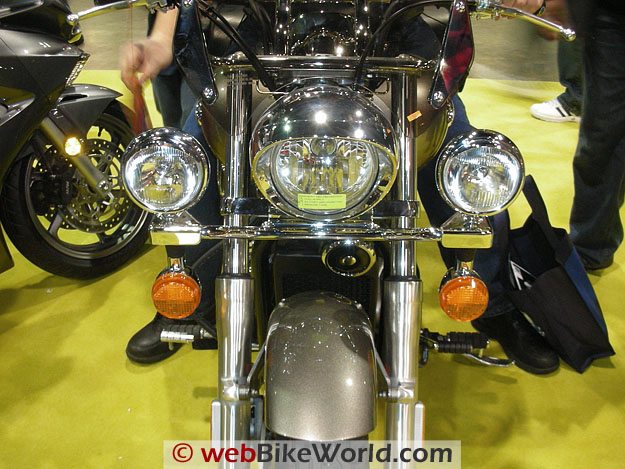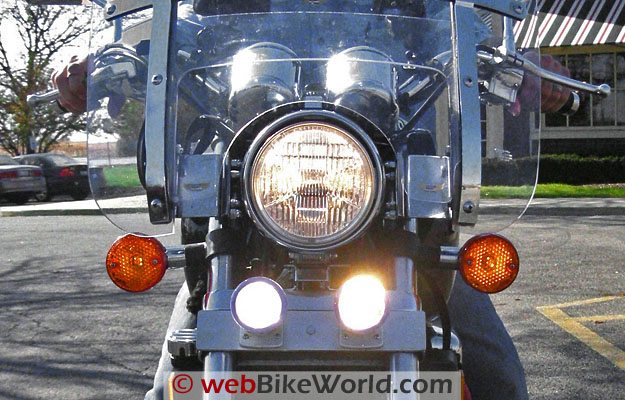Adding a set of auxiliary driving lights to a motorcycle is one of the most popular and affordable user-installed projects undertaken by the average rider to enhance the looks or safety of their bike.
A few of today’s bigger cruisers and touring bikes come with some type of auxiliary lights already installed or available as a dealer-installed option.
But many older bikes, especially sport, dual-purpose, and smaller cruisers, typically don’t have them.
If you’ve been thinking about adding an extra set of lights to your bike, hold off on making that run to the local cycle shop, auto parts store, or Walmart.
And don’t hop on to the Internet with a credit card in hand to order that cool looking set of Master Blaster driving lights just yet.
Take a few minutes to answer the following questions.
By doing so, you’ll be able to make a more intelligent decision about which set of lights to buy.
1) Why Are You Adding A Set Of Lights?
People add lights to their motorcycle for a variety of reasons ranging from aesthetics to enhanced safety.
Do you want to add lights to your bike to supplement your existing low-beam lights, extend the range of your existing high beam lights, make your bike more conspicuous to oncoming daytime drivers, or just to make it look “cool”?
The answer to this question will go a long ways in determining what features you are going to want in a set of lights.
Auxiliary driving lights typically come in two varieties: lights that project a somewhat short but wide light pattern (a 30 to 35 degree spread is common) and lights that project a longer and narrower light pattern (20 degrees).
The 35 degree pattern is intended to enhance and slightly extend the existing illumination provided by your low beam headlight, while the 20 degree pattern is intended to supplement your existing long-range high beam pattern.
A wide light pattern will provide added visibility to enable you to see objects positioned on or along the sides of the road like deer, stopped vehicles, or someone out for a late night jog.
A longer, more concentrated light pattern will help you to see objects on the road itself and hopefully give you the added time you need to avoid them.
Almost any type of light added to the front of your bike will serve the purpose of making you more visible to oncoming traffic.
If that is what you’re trying to accomplish, remember that you don’t need the latest and greatest high-priced technological marvel to accomplish this purpose. Keep this in mind when you’re shopping.
2) How Many Lights and What Kind Of Lights?
The number of lights that you want to add to your bike will be somewhat dependent upon the capacity of the electrical system on your bike.
If it has the extra capacity to support an additional 110 to 150 watts of power, using conventional lights is an easy solution.
A typical set of driving lights, each drawing 55 watts of power, will need an additional 110 watts of power to operate properly.
However, if your bike’s electrical system output is limited, you may be forced to consider using more energy efficient lighting systems like LED lights or more expensive HID (High Intensity Discharge) Xeon lights.
Occasionally, you’ll see a bike whose owner has gone above and beyond the norm by adding driving lights, conspicuity lights, fog lights, and marker lights, not to mention the undercarriage-mounted neon lights, designed to give the bike a colored, glowing appearance at night.
All of these lights require power, and the more you want to add to your bike, the more power the electrical system on the bike is going to have to generate to keep them burning brightly.
Just about anything can be done, it just depends upon how thick your wallet is!
3) Does Your Bike Have Enough Electrical Power?
Once you’ve decided on the number and types of lights you want to add, you need to calculate the extra power your bike will need to power them.
This is a technical issue that you should discuss with your local dealer.
Every motorcycle has a rated amount of electrical power that the bike’s system can generate to keep it running and to power various items like the headlights, tail lights, turn signals, fan motor, instrument lights, and various electrical sensors located throughout the bike.
Beyond that, most bikes can support another 100-200 Watts of power to run miscellaneous electrical items like connections for a GPS unit, a radio, or radar detector, or a set of fog and/or driving lights.
The amount of extra power is going to vary from bike model to model, so it’s best to talk to the people who know your bike best — your local dealer.
You can do some preliminary research by checking the Owner’s Manual for your bike and looking for an entry in the “Specifications” section called “Generator Charging Capacity” or “Generator Output”.
For example, the Owner’s Manual for my 2002 Honda Magna VF750C lists the charging capacity of my bike’s electrical system at 0.374 kW/5,000 rpm.
If we multiply 0.374 x 1,000 (a kilowatt) and that tells me that my bike generates 374 watts of power when the engine is turning 5,000 revolutions per minute.
I figured that I had at least an extra 200 watts of power available to run the set of driving lights (2 lights x 55 watts per light) that I installed on my bike, with room to spare.
If your bike is borderline in terms of electrical capacity for the number and types of lights that you want to add, you’re now going to have to deal with a couple of other issues:
a) upgrading the generator on your bike to enable it to produce more electrical power, and b) upgrading some of the wiring on your bike to a larger gauge wire capable of handling the extra heat generated by the increased current flow to all of those lights.
This is another cost factor that you may need to consider if you plan on adding more than a couple of extra lights.
4) How Much Do You Want To Spend?
Additional lights for your bike can range from inexpensive fog or driving light sets available at Walmart ($ 29.95 per pair) to expensive, top-of-line units designed to withstand the rigors of nighttime off-road travel and costing upwards of $ 500.00 to $ 1,000.00.
Price does not always mean “better” — there are many lighting products on the market that offer good reliability and performance at a very reasonable price.
Check motorcycle User Groups or Forums for comments from other bikers about the lighting systems they have installed on their bikes.
They can provide invaluable information on those specific models and brands that work as advertised or those that don’t live up to all the hype.
5) Where Will You Mount the Lights?
Driving lights and fog lights are designed to address different needs and as such, are typically mounted in different ways.
Most experienced riders want to mount fog lights as low to the ground as possible, generally about 12 to 16 inches above the roadway, in order to get the best results.
Driving lights, on the other hand, should be mounted as high as possible in order to take advantage of the unique lighting pattern that they offer when pointed in a downward angle toward the road surface.
Adding driving lights to any bike presents its own unique challenges.
Sport bikes generally don’t offer a lot of mounting options due to their carbon or fiberglass bodywork.
Most sport bike manufacturers have not provided reinforced mounting points inside the bodywork for adding auxiliary lights, so you need to think creatively.
Look at other sport bikes that have auxiliary lights to get some ideas.
Generally, sport bike users need to consider small, compact units that can be tucked up and under the front of the sport bike’s bodywork or attached with special brackets that either bolt or clamp to the front fork tubes.
Cruisers and dual-purpose bikes offer far more options. Their open, exposed framework allows more flexibility to either purchase ready-made brackets for a particular bike or adapt some type of universal brackets to meet this particular need.
6) How Are You Going To Mount the Lights?
There are host of products available on-line by such manufacturers as Kuryakyn, Lumalink, and PIAA that can be used to attach virtually any accessory to your motorcycle, ranging from lights to horns to deer whistles.
Finding one that matches the particular type of bracket that comes with the auxiliary driving light set you want to purchase may not be so easy.
Many driving light sets either come with:
a) a single-bolt design bracket which can be used with a wide variety of commercially-available mounting brackets, or b) with some type of u-shaped bracket with a wide flat bottom piece containing several oblong holes that can be used for positioning mounting screws or bolts.
This type of bracket presents a far greater challenge in terms of matching it with an easy-to-install, readily available mounting bracket. Some ingenuity and creativity may be called for to successfully mount these light sets.
I own a 2002 Honda Magna, a well-respected 750cc sport-cruiser.
In order to add a set of auxiliary driving lights to my bike I had to fashion my own bracket from a 12” x 2” wide piece cut from an aluminum yardstick, backed by a block of black Delrin purchased from McMaster-Carr, and a 12” piece of 6061 aluminum cut and shaped to suit my purpose.
These components were then sandwiched together and bolted between the top of my front forks to hold two small driving lights. In the end, it all worked, but I would have preferred a simpler solution.
7) How Will You Orient Your New Lights?
By “orient” I mean, are you going to have the lights sitting upright or hanging inverted or upside-down from their mounting brackets?
The answer to this question is going to determine the type of mounting bracket you use and where on the front of the bike you are going to mount the lights.
Most light bars that you see advertised for cruisers today generally mount the two driving lights in an upright orientation on either side of and at approximately the same height as the headlight.
Light bars are a great way to go, unless your bike has a windshield that interferes with the addition of a light bar, or you have a hard time finding an appropriate light bar kit made specifically for your year/make/model bike.
If your light/bracket combination requires you to hang your lights in an upside-down orientation, this is going to place them several inches closer to the pavement.
Now, instead of having a “three-lights-across” look with your headlight and driving lights at the same height, you’re going to have a “triangle” or “pyramid” look.
This puts your headlight at the top of the triangle and your driving lights positioned below and on either side at the base of the triangle.
This is actually a good thing, since it will make your bike look different from other vehicles on the road and get the attention of those “not-so-alert” oncoming motorists.
8) How Are You Going To Power the New Lights?
Regardless of which light set you choose, it’s going to need power.
Most experts recommend powering your lights directly from the battery and not tapping into the existing high or low beam wiring for power.
The added load generated by a set of auxiliary lights may be enough to melt the existing wiring harness carrying power to those units.
Most driving light sets use an H3/55-watt bulb for illumination. Two driving lights will typically draw 110 watts of power from your bike’s electrical system.
Using LED or HID light systems is a viable way of controlling the amount of power your bike will be required to produce to power your additional lights
9) How Are You Going To Switch the New Lights?
How you control your lights is going to be up to you. Some people want to wire their lights so that they’re “on” anytime the bike’s electrical system is “on”.
The low beam lights on your motorcycle are an example of this concept. This can be accomplished with the use of a relay spliced into your low beam circuit wiring.
Others want to be able to turn their auxiliary lights “on” and “off” manually using a handlebar-mounted toggle or rocker switch depending upon driving conditions and time of day.
Still others want their lights to be active only when their high beam lights are on. Once again, a relay spliced into the high beam circuit can be used to trigger the auxiliary driving light set when the high beam light is active.
These various options are typically going to fit one type of light (35 degree wide-spread vs. 20 degree long-range) better than another.
[Editor’s Note: We always use the Eastern Beaver relay wiring harness kits for adding horns or lights.These are high-quality, plug-and-play wiring harnesses all ready to go with a built-in relay, fuse and terminals. See the wBW Motorcycle Headlight Relay review for all the details.]
This article is not intended to deal with how to wire your lights.
There are numerous articles on the web and in various “User Groups” dealing with this topic. Simply be aware that this is one of the questions you will need to address when you install your new lights.
At least one manufacturer is now offering an auxiliary driving light set with remote control activation of the lights via a small key fob.
IPF Light Products’ RE11 high performance driving light set (web site URL) is one of the only such sets that I’m familiar with that offers this feature.
Hopefully other manufacturers will follow suit and start offering this feature with the light sets that they offer.
It eliminates the need for an additional switch on the handlebars and simplifies the wiring of the lights greatly. Check it out.
One Caveat
DO NOT rely uponthe diagram shown on the box depicting the light pattern projected by any driving light set. They are absolutely useless!
No manufacturer that I know of displays an actual photograph of the light pattern produced by their light as it appears in real life. If they were to do so, many driving light sets would never sell because of poor light patterns.
Here’s what I did — I bought several different driving light sets and tested them myself. It’s simple to do. Just open each box and carefully remove one of the two lights contained in the set.
Hook the black wire from the light to a lead from the positive terminal on a 12-volt car battery and the white wire to the negative terminal on the battery.
Shine the resulting light pattern on a large outdoor wall, like the side of your house, a school building, or the side of a neighbor’s house.
Doing this helped me to see what type of coverage, intensity, and shape the resulting light produces. It gave me a good feel for what I liked and didn’t like almost immediately.
I did this with 9 different sets of lights before settling on the set that I liked the best. In some cases I just shook my head wondering how any company could sell a light that was so poor.
Once I completed my tests, I returned the units that I didn’t want.
Conclusion
Adding a set of high performance auxiliary driving lights is generally a rather simple and affordable upgrade that can significantly enhance not only the safety of your bike, but also its looks.
Just take your time before rushing out to buy a set of lights and I think you’ll be well satisfied with your final decision!
Also by Darryl: Platinum Burner Driving Lights Review
Publication Date: February 2009
Owner Comments and Feedback
See details on submitting comments.
From “D.G.” (04/11): “Thought tip #8 was way too thin on details and good luck finding wiring news-you-can use online.
Having installed all kinds of lights on cycles, from tractor lights using metal conduit for a bar, to exotic custom stuff, I have become an old hand at these setups.
My cruiser has running lights able to go wig-wag on high beam while passing a cager or if someone is coming from the opposite direction and in our lane. Very sexy when you need it and the cop look ain’t a bad attention getter either (unless prohibited by state law).
The author is right, lift your power from the battery.
Be sure an place the appropriate in-line fuse. Add to your stock wiring then stand by for frequent fuse failures or fried harnesses.
Try this: Use a standard automobile relay ($5 to $8 from NAPA) to turn the lights on.
They normally have four connections but some have a fifth which is Normally Closed (NC). This is in the relay’s center and don’t use it for this application. Most have a diagram printed on them with odd numbers.
Here are the four main suspects of interest with matching diagram numbers:
- You have a main power in from the battery.
- Main power out to the device – in this case your lights.
- A ground and the fourth contact.
- A tiny bit of current to tell the relay to switch to the ‘ON’ state. Ask a buddy or test it using jumpers on a 12 battery to get it to go ‘click’ and test power two lights.
You can tie that last wire in a number of ways:
- To any circuit normally on when you turn the key. This could be fuel pump, tail light, speedo lamp, etc. If your front signals operate as amber running lights but go dark during turn signal use, they are not a good candidate.
- Add to your low beam power wire. They will turn off on high beam, tho’. You can swap out the 55W H3 lamps for 35W H3 lamps to reduce stator demand and the risk of frying it.
Lower wattage is especially recommended if also running heated grips, jacket, socks, coffee maker, stereo, radar detector, GPS, cocktail blender, radios, yadda, yadda.
Finally, we tried in vain to add running lights to the wife’s 250cc Rebel.
Even 35W lamps sucked all the current out of the stator plus drained the battery. Little bikes are not good candidates for incandescent additions, try LEDs instead.”
Editor’s Note: We always use the Eastern Beaver relay wiring harness kits for adding horns or lights. These are high-quality, plug-and-play wiring harnesses all ready to go with a built-in relay, fuse and terminals.
See the wBW Motorcycle Headlight Relay review for all the details.


